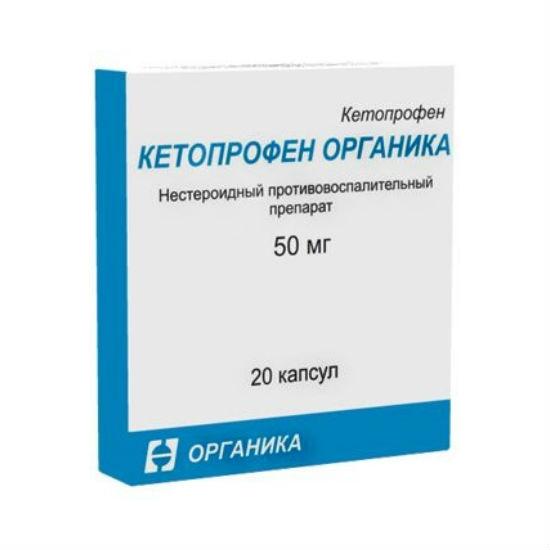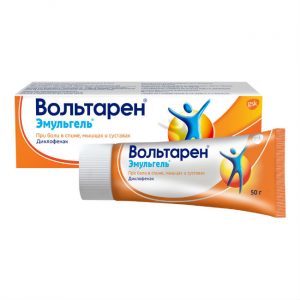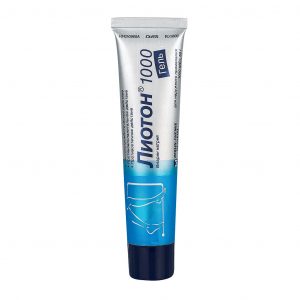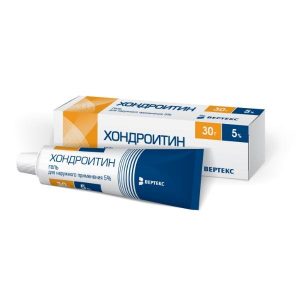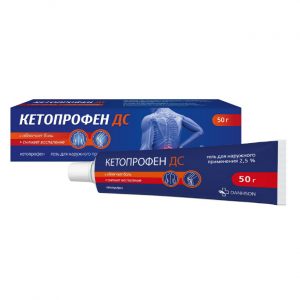Description
Latin name
Ketoprofen
Release form
Capsules.
packaging 10 pcs – blister packs (2) – packs of cardboard.
Pharmacological action of
NSAIDs, a derivative of propionic acid. It has anti-inflammatory, analgesic and antipyretic effects associated with the suppression of the activity of COX-1 and COX-2, regulating the synthesis of GHGs. By acting on the cyclooxygenase and lipoxygenase link in the metabolism of arachidonic acid, it inhibits the synthesis of PG, LT and Tx. It has a central and peripheral analgesic effect, powerful anti-bradykinin activity, stabilizes lysosomal membranes, and causes a significant inhibition of neutrophil activity in patients with rheumatoid arthritis. Does not have a catabolic effect on articular cartilage.
Anti-inflammatory effect occurs at the end of the 1st week of admission.
Pharmacokinetics
Absorption
Absorption is fast, bioavailability is over 90%. Ketoprofen is quickly and fairly completely absorbed from the digestive tract. T1 / 2 by ingestion – 1-2 hours.
Distribution of
Up to 99% of the absorbed ketoprofen binds to plasma proteins, mainly to albumin. Cmax of the drug in plasma is reached quickly due to low Vd (concentration – 0.1-0.2 l / kg). Kss of ketoprofen is achieved 24 hours after the start of its regular intake.
Ketoprofen penetrates well into the synovial fluid and connective tissue. In a significant amount does not penetrate the BBB. Although the concentrations of ketoprofen in the synovial fluid are slightly lower than in plasma, they are more stable (stored up to 30 hours), as a result of which pain and joint stiffness are reduced for a long time.
metabolism, excretion of
Ketoprofen is mainly metabolized in the liver, where it undergoes glucuronidation to form esters with glucuronic acid excreted by the kidneys (60 80%) in 24 hours. Excretion with feces is less than 1%. T1 / 2 of ketoprofen ranges from 1.6 to 1.9 hours. It does not have cumulative properties due to its rapid and fairly complete excretion.
Indications
Inflammatory and degenerative diseases of the musculoskeletal system: rheumatoid, psoriatic arthritis, ankylosing spondylitis (ankylosing spondylitis), gouty arthritis (with an acute attack of gout, fast-acting dosage forms are preferred), osteoarthritis. Intended for symptomatic therapy, reduce pain and inflammation at the time of use, does not affect the progression of the disease.
Pain syndrome: myalgia, ossalgia, neuralgia, tendonitis, arthralgia, bursitis, radiculitis, adnexitis, otitis media, headache and toothache, with cancer, post-traumatic and postoperative pain syndrome, accompanied by inflammation.
Algodismenorea, childbirth (as an analgesic and tocolytic agent).
Contraindications
Hypersensitivity (including to other NSAIDs), bronchial asthma, rhinitis or urticaria in history, caused by taking ASA or other NSAIDs,
peptic ulcer and duodenal ulcer (exacerbation), ulcerative colitis (exacerbation), Crohn’s disease, diverticulitis, peptic ulcer,
hemophilia and other blood coagulation disorders, active gastrointestinal bleeding
severe renal failure (CC less than 30 ml / min), progressive kidney disease, severe liver failure or active liver disease, condition after coronary artery bypass grafting, confirmed hyperkalemia, inflammatory bowel disease,
childhood (up to 6 em), pregnancy (III trimester).
Caution. Anemia, bronchial asthma, alcoholism, smoking,
alcoholic cirrhosis of the liver, hyperbilirubinemia, liver failure, dehydration,
sepsis, heart failure, edema, arterial hypertension, blood diseases (including leukopenia), stomatitis, coronary heart disease, cerebrovascular disease, dyslipidemia / hyperlipidemia, diabetes mellitus, peripheral artery disease, chronic renal failure (CC 30-60 ml / min),
history of gastrointestinal ulceration, the presence of Helicobacter pylori infection, prolonged use of NSAIDs, severe somatic diseases, srd simultaneous administration of oral GCS (including prednisone), anticoagulants (including warfarin), antiplatelet agents (including clopidogrel), selective serotonin reuptake inhibitors (including citalopram, fluoxetine, paroxetine, sertraline),
old age ast, pregnancy (I, II trimester), lactation.
Use during pregnancy and lactation
Contraindicated in pregnancy in the third trimester (especially after 36 weeks) due to a possible effect on uterine tone.
Use with caution in pregnancy in the I and II trimester, if the expected effect of therapy exceeds the potential risk to the fetus.
Women planning a pregnancy should refrain from using ketoprofen, as while taking it, the probability of egg implantation may decrease.
Like other substances that pass into breast milk, ketoprofen is not recommended for use by nursing mothers.
Composition
1 caps.
ketoprofen 50 mg
Excipients: hyprolose (hydroxypropyl cellulose clucel LF) – 1.2 mg, mannitol (mannitol) – 10.5 g, croscarmellose sodium (primellose) – 2.7 mg, microcrystalline cellulose – 24.2 mg, colloidal silicon dioxide (0.5 mg, aerosil) magnesium stearate – 0.9 mg.
Composition of capsule shell: sunset yellow (E110) or sunset yellow – 2%, gelatin – up to 100%.
Dosage and administration
Inside, during or immediately after a meal, without chewing, with plenty of water.
Adults and teenagers (15 18 years of age) are prescribed 4 caps. drug per day, which can be divided into 3 doses (depending on the severity of the pain syndrome), but not more than 2 caps. once. The maximum daily dose should not exceed 200 mg.
Side effects
Frequency is classified as rare – from 0.01 to 0.1% very rarely –
Digestive system: NSAIDs gastropathy, abdominal pain, dyspepsia (nausea, vomiting, heartburn, flatulence, decreased appetite, diarrhea), stomatitis, impaired liver function rarely – erosive and ulcerative lesions, bleeding and perforation of the gastrointestinal tract, taste change.
From the nervous system: headache, dizziness, insomnia, agitation, nervousness, drowsiness, depression, asthenia rarely – confusion or loss of consciousness, forgetfulness, memory impairment, migraine, peripheral neuropathy.
On the part of the sensory organs: noise or ringing in the ears, blurred visual perception rarely – conjunctivitis, dry eyes, eye pain, conjunctival hyperemia, hearing loss, dizziness additionally for capsules – vertigo.
From the CCC: edema, increased blood pressure rarely – tachycardia.
From the respiratory system: hemoptysis, dyspnea, pharyngitis, rhinitis, bronchospasm, laryngeal edema (signs of anaphylactic reaction) rarely – asthma attacks.
From the hemopoietic organs: rarely – agranulocytosis, anemia, hemolytic anemia, thrombocytopenia, leukopenia. High doses of ketoprofen can inhibit platelet aggregation, prolonging bleeding time, and cause nosebleeds and hematomas. From the urinary system: edematous syndrome rarely – cystitis, urethritis, impaired renal function, interstitial nephritis, rarely – hematuria nephrotic syndrome. aspects of the immune system: reactivity of the respiratory system, including bronchial asthma, its exacerbation of bronchospasm or shortness of breath (especially in patients with hypersensitivity to acetylsal tsilovoy acid and other NSAIDs) very rarely – angioedema and anafilaksiya.Allergicheskie reactions: skin rash (including erythematous, urticaria), skin itching, rhinitis rarely – exfoliative dermatitis. Other: increased sweating rarely – hemoptysis, nosebleeds, myalgia, muscle twitching, shortness of breath, thirst, photosensitivity, with prolonged use in large doses – vaginal bleeding.
Drug Interaction
Pharmaceutically incompatible with tramadol solution.
Reduces the effectiveness of uricosuric drugs, increases the action of anticoagulants, antiplatelet agents, fibrinolytics, ethanol, side effects of ACS and ISS, estrogens, reduces the effectiveness of antihypertensive drugs and diuretics.
Co-administration with other NSAIDs, GCS, ethanol, corticotropin can lead to ulcer formation and gastrointestinal bleeding, to increase the risk of kidney dysfunction.
Concurrent administration with oral anticoagulants, heparin, thrombolytics, antiplatelet agents, cefaperazone, cefamandol and cefotethan increases the risk of bleeding.
Increases hypoglycemic action of insulin and oral hypoglycemic drugs (dose adjustment is required).
Inductors of liver microsomal enzymes (phenytoin, ethanol, barbiturates, rifampicin, phenylbutazone, tricyclic antidepressants) increase the production of hydroxylated active metabolites.
Co-administration with valproic acid causes impaired platelet aggregation.
Increases plasma concentration of verapamil and nifedipine, Li + drugs, methotrexate.
Antacids and cholestyramine reduce absorption.
Myelotoxic drugs increase the manifestations of hematotoxicity of the drug.
Overdose
The overdose has not been reported.
Treatment: symptomatic, no specific antidote for the drug exists.
Storage conditions
In the dark place at a temperature of no higher than 30 ° C. Keep out of the reach of children.
Expiration
2 years.
Deystvuyuschee substances
Ketoprofen
Terms of delivery from
pharmacies Prescription
dosage form
dosage form
capsules
Organics, Russia
